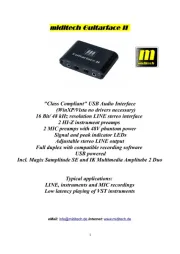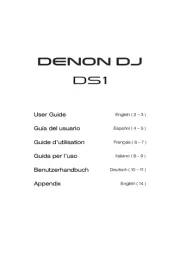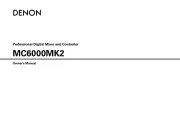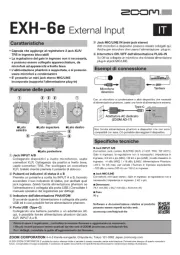IMG Stage Line MX-1IO Handleiding
IMG Stage Line
DJ Gear
MX-1IO
Bekijk gratis de handleiding van IMG Stage Line MX-1IO (4 pagina’s), behorend tot de categorie DJ Gear. Deze gids werd als nuttig beoordeeld door 55 mensen en kreeg gemiddeld 4.5 sterren uit 28 reviews. Heb je een vraag over IMG Stage Line MX-1IO of wil je andere gebruikers van dit product iets vragen? Stel een vraag
Pagina 1/4

ELECTRONICS FOR SPECIALISTS ELECTRONICS FOR SPECIALISTS ELECTRONICS FOR SPECIALISTS ELECTRONICS FOR SPECIALISTS ELECTRONICS FOR SPECIALISTS ELECTRONICS
MX-1IO Bestell-Nr. 20.3160
MX-2IO Bestell-Nr. 20.3170
MONACOR INTERNATIONAL GmbH & Co. KG • Zum Falsch 36 • 28307 Bremen • Germany
Copyright© by MONACOR INTERNATIONAL. All rights reserved. A-1933.99.02.02.2019
CLIP
0 d B
−3
−6
−10
−15
CLIP
0 d B
−3
−6
−10
−15
MONIN L R
MX-1IO
MX-2IO
PC
SPEAKER
MON
OUT
R
L
LINE
|
INST
IN
MIC
IN
LINE
LINE
MIC |L
IN
PC
SPEAKER
MON
OUT
LINE
|
INST
IN LINE
|
INST
IN
2 1MIC|R
IN
R
L
48V INST48V INST STPADPAD AUX
M
1| L 2|R MONIN MON
48V INSTPAD AUX
LINE
MONL RIN1 2
48V1 2
48V
7 8 9 910 1011 13 11 12 13
6 7 86 7 86
14 15 16 17 18 14 15 16 17 18 17 18
4 5 4 521 13 2 3
VORSICHT Stellen Sie die Lautstärke der
Lautsprecher und des Kopf-
hörers nie sehr hoch ein. Hohe
Lautstärken können auf Dauer
das Gehör schädigen! Das Ohr gewöhnt
sich an hohe Lautstärken und empfindet sie
nach einiger Zeit als nicht mehr so hoch. Er-
höhen Sie darum eine hohe Lautstärke nach
der Gewöhnung nicht weiter.
5) Bei dem Modell MX-2IO für die Eingänge
LINE
| INST IN (17) und MIC IN (18) mit dem
Schalter ST / M (12) stereo oder mono wählen.
5 Technische Daten
Eingänge
(Eingangsempfindlichkeit / Impedanz; Anschluss)
MIC: � � � � � � � � � � � � � �2,5 mV (mit PAD 25 mV) /
4 kΩ; XLR sym�, 48-V-Phan-
tomspeisung zuschaltbar
LINE | INST: � � � � � � � � �45 mV (mit PAD 450 mV) /
11 kΩ (INST 460 kΩ);
6,3-mm-Klinke, asym�
AUX: � � � � � � � � � � � � � �1,25 V / 6,5 kΩ;
3,5-mm-Klinke, asym�, stereo
USB-Ein- /Ausgang: � � �Vollduplex, 16 Bit oder
24 Bit, 44,1 kHz oder 48 kHz
Ausgänge
MONITOR OUT: � � � � � �0 – 500 mV,
6,3-mm-Klinke, asym�
PC SPEAKER: � � � � � � � �0 – 500 mV,
3,5-mm-Klinke, stereo
Kopfhörer: � � � � � � � � � �
≥ 16 Ω, 3,5-mm-Klinke, stereo
Allgemein
Frequenzbereich: � � � � �20 Hz – 20 kHz
Klirrfaktor: � � � � � � � � � �≤ 0,03 %
Übersprechdämpfung: �92 dB
Stromversorgung: � � � � 5 V, 500 mA über ⎓
USB-Anschluss
Einsatztemperatur: � � � �0 – 40 °C
Maße (B × H × T), Gewicht
MX-1IO: � � � � � � � � � �120 × 50 × 110 mm, 500 g
MX-2IO: � � � � � � � � � �160 × 50 × 110 mm, 634 g
Änderungen vorbehalten.
1 Eingangspegelregler
2 Pegelanzeige des Eingangssignals
3 Pegelanzeige für den Monitorweg
4 Regler für den Ausgangspegel des Monitorwegs
5 Regler für die Kopfhörerlautstärke
6 Phantomspeisung Ein /Aus für MIC IN (18)
7 Abschwächschalter für das Eingangssignal: −20 dB
8 Impedanzumschalter Audiogerät / Instrument für
den Eingang LINE | INST IN (17)
9 Anzeige „48 V“: Leuchtet bei eingeschalteter
Phantomspeisung für MIC IN (18)
10 Anzeige : Leuchtet, wenn das Interface mit
einem eingeschalteten Computer verbunden ist
11 Stereoeingang (Pegel nicht einstellbar) für ein
Audio gerät
12 Nur MX-2IO: Umschalter stereo / mono für die
Eingänge LINE | INST IN (17) und MIC IN (18)
13 Kopfhöreranschluss
14 Computeranschluss
15 + 16 Anschlüsse Aktivlautsprecher
17 Anschluss für Audiogerät oder Instrument
18 entwederMikrofonanschluss; diese Buchse
benutzen die Buchse LINE oder | INST IN (17)
USB-Recording-Interface
Diese Anleitung richtet sich an Benutzer mit
Grundkenntnissen in der Audiotechnik und
Computerbedienung. Bitte lesen Sie die An-
leitung vor dem Betrieb gründlich durch und
heben Sie sie für ein späteres Nachlesen auf.
1 Verwendungsmöglichkeiten
Das MX-..IO dient zur Audioaufnahme auf einem
Computer und wird von diesem als externe
Soundkarte erkannt. Es wandelt das analoge Sig-
nal eines Mikrofons, Instruments oder einer Ton-
quelle mit Line-Pegel (Mischpult, MP3- / CD-Spie-
ler, Vorverstärker usw.) in ein digitales Signal für
den Computer um. Andersherum lassen sich auf
dem Computer abgespielte Audiodateien über
Aktivlautsprecher und Kopfhörer wiedergeben.
Die Stromversorgung erfolgt über den USB-
Anschluss des Computers. Ein Anschluss kabel
wird mitgeliefert.
2 Wichtige Hinweise
Das Gerät entspricht allen relevanten Richtlinien
der EU und trägt deshalb das -Zeichen.
•
Verwenden Sie das Gerät nur im Innenbereich
und schützen Sie es vor Tropf- und Spritzwasser
sowie vor hoher Luftfeuchtigkeit. Der zulässige
Einsatztemperaturbereich beträgt 0 – 40 °C.
•
Verwenden Sie zum Säubern nur ein trocke-
nes, weiches Tuch, niemals Wasser oder Che-
mikalien.
•
Wird das Gerät zweckentfremdet, nicht richtig
angeschlossen, falsch bedient oder nicht fach-
gerecht repariert, kann keine Haftung für dar-
aus resultierende Sach- oder Personenschäden
und keine Garantie für das Gerät übernom-
men werden.
Soll das Gerät endgültig aus dem Be-
trieb genommen werden, übergeben
Sie es zur umweltgerechten Entsor-
gung einem örtlichen Recyclingbetrieb.
3 Geräte anschließen
Wichtig! Vor dem Anschluss eines Mikrofons
die Position des zugehörigen Schalters „48V“(6)
überprüfen:
Obere Position: Phantomspannung ein
Untere Position: Phantomspannung aus
Mikrofone mit asymmetrischem Ausgangssignal
können durch die Phantomspannung beschädigt
werden. Die Phantomspannung nur einschalten,
wenn ein Mikrofon diese benötigt ☞ Technische
Daten des Mikrofons.
Anschlüsse
Gerät Buchse Position
Computer USB 14
Instrument LINE | INST IN* 17
Tonquelle mit Line-Pegel
Mikrofon MIC IN* 18
Audiogerät, stereo AUX 11
Kopfhörer 13
Aktivlautsprecher PC SPEAKER 15
MON OUT 16
* Die Signale der Buchsen 17 und 18 werden zusam-
mengeführt; darum nur eine der Buchsen je Kanal
verwenden.
4 Bedienung
Nach dem Anschluss an einen Computer leuch-
tet die Anzeige (10).
1) Für eine an der Buchse LINE
| INST IN (17)
angeschlossene Tonquelle die Impedanz des
Eingangs mit dem Schalter INST / LINE (8) an-
passen:
LINE = Tonquelle mit Line-Pegel
INST = Instrument (höhere Eingangsimpedanz)
2) Mit dem Eingangsregler IN (1), Modell MX-
2IO Regler 1
| L und 2
| R, das Interface so aus-
steuern, dass bei den lautesten Passagen die
LED „0 dB“ der Pegelanzeige (2) aufleuchtet.
Die LED „CLIP“ darf nicht aufleuchten; sie
zeigt Verzerrungen an.
3) Zu hohe Eingangspegel lassen sich mit dem
Schalter PAD (7) um 20 dB dämpfen (obere
Position).
Hinweis: Die Aussteuerung für ein an der Buchse
AUX (11) angeschlossenes Gerät muss direkt an
dem Gerät erfolgen oder ggf. mit einem dazwi-
schen geschalteten Pegelregler (z. B. ILA-100XLR).
4) Mit dem Regler MON (4) die Lautstärke für
die Aktivlautsprecher einstellen, die an den
Buchsen PC SPEAKER (15) und MON OUT (16)
angeschlossen sind. Mit dem Regler (5) die
Lautstärke für den Kopfhörer einstellen.
Deutsch

ELECTRONICS FOR SPECIALISTS ELECTRONICS FOR SPECIALISTS ELECTRONICS FOR SPECIALISTS ELECTRONICS FOR SPECIALISTS ELECTRONICS FOR SPECIALISTS ELECTRONICS
MONACOR INTERNATIONAL GmbH & Co. KG • Zum Falsch 36 • 28307 Bremen • Germany
Copyright© by MONACOR INTERNATIONAL. All rights reserved. A-1933.99.02.02.2019
CLIP
0 d B
−3
−6
−10
−15
CLIP
0 d B
−3
−6
−10
−15
MONIN L R
MX-1IO
MX-2IO
PC
SPEAKER
MON
OUT
R
L
LINE
|
INST
IN
MIC
IN
LINE
LINE
MIC |L
IN
PC
SPEAKER
MON
OUT
LINE
|
INST
IN LINE
|
INST
IN
2 1MIC|R
IN
R
L
48V INST48V INST STPADPAD AUX
M
1| L 2|R MONIN MON
48V INSTPAD AUX
LINE
MONL RIN1 2
48V1 2
48V
7 8 9 910 1011 13 11 12 13
6 7 86 7 86
14 15 16 17 18 14 15 16 17 18 17 18
4 5 4 521 13 2 3
1 Input level control
2 LED level indicators of the input signal
3 LED level indicators for the monitor path
4 Control for the output level of the monitor path
5 Control for the headphone volume
6 Phantom power on / off for MIC IN (18)
7 Attenuator switch for the input signal: −20 dB
8 Impedance selector switch to switch between audio
unit / instrument for the input LINE | INST IN (17)
9 LED indicator “48 V”: Will light up when phan-
tom power for MIC IN (18) is activated
10 LED indicator : Will light up when the interface
is connected to a computer that is switched on
11 Stereo input (level cannot be adjusted) for an
audio unit
12 MX-2IO only: Selector switch to switch between
stereo and mono for the inputs LINE | INST IN (17)
and MIC IN (18)
13 Headphone connection
14 Computer connection
15 + 16 Connections for active speakers
17 Connection for audio unit or instrument
18 eitherConnection for microphone; use this jack
or the jack LINE | INST IN (17)
MX-1IO Order number 20.3160
MX-2IO Order number 20.3170
USB Recording Interface
These instructions are intended for users
with basic knowledge in audio technology
and computer handling. Please read the in-
structions carefully prior to operation and
keep them for later reference.
1 Applications
The recording interface MX-…IO is used to make
audio recordings on a computer; it is recognized
by the computer as an external sound card. The
interface transforms the analog signal of a mi-
crophone, instrument or audio source with line
level (mixer, MP3 / CD player, preamplifier etc.) to
a digital signal for the computer. Also, audio files
replayed on the computer can be reproduced via
active speakers or headphones.
The interface is supplied with power via the
USB port of the computer. A connection cable
is supplied.
2 Important Notes
The unit corresponds to all relevant directives of
the EU is therefore marked with .
•
The unit is suitable for indoor use only. Pro-
tect it against dripping water, splash water
and high air humidity. The admissible ambient
temperature range is 0 – 40 °C.
•
For cleaning only use a dry, soft cloth; never
use water or chemicals.
•
No guarantee claims for the unit and no liabil-
ity for any resulting personal damage or mate-
rial damage will be accepted if the unit is used
for other purposes than originally intended, if
it is not correctly connected or operated, or if
it is not repaired in an expert way.
If the unit is to be put out of operation
definitively, take it to a local recycling
plant for a disposal which is not harm-
ful to the environment.
3 Connecting Units
Important! Before connecting a microphone,
always check the position of the corresponding
switch “48 V” (6):
Upper position: phantom power activated
Lower position: phantom power deactivated
Phantom power may damage microphones with
unbalanced output signal. Only activate the
phantom power when it is required by the mi-
crophone ☞ Specifications of the microphone.
Connections
Unit Jack Position
Computer USB 14
Instrument
LINE | INST IN* 17
Audio source
with line level
Microphone MIC IN* 18
Audio unit, stereo AUX 11
Headphones 13
Active speakers PC SPEAKER 15
MON OUT 16
* The signals of the jacks 17 and 18 will be combined;
therefore, only use one jack for each channel.
4 Operation
The LED indicator (10) will light up as soon
as the interface recorder is connected to a com-
puter.
1) For an audio source connected to the jack
LINE | INST IN (17), adjust the impedance of the
input by means of the switch INST / LINE(8):
LINE = audio source with line level
INST = instrument (higher input impedance)
2) Use the input control IN (1) [Model MX-2IO:
control 1 | L and 2
| R] to adjust the interface in
such a way that the LED “0 dB” of the level
indicators (2) will light up with music peaks.
The LED “CLIP” may not light up; it indicates
distortions.
3) Use the switch PAD (7) to attenuate input lev-
els that are too high by 20 dB (upper position).
Note: A unit connected to the jack AUX (11) must
be either adjusted at the unit itself or, if applica-
ble, by means of an inserted level control (e. g.
ILA-100XLR).
4) Use the control MON (4) to adjust the volume
for the active speakers connected to the jacks
PC SPEAKER (15) and MON OUT (16). Use
the control (5) to adjust the volume for the
headphones.
CAUTION Never adjust the speakers or
the headphones to a very high
volume. Permanent high vol-
umes may damage your hear-
ing! Your ear will get accustomed to high
volumes which do not seem to be that high
after some time. Therefore, do not further in-
crease a high volume after getting used to it.
5) Model MX-2IO: Use the switch ST/ M (12)
to select “stereo” or “mono” for the inputs
LINE
| INST IN (17) and MIC IN (18).
5 Specifications
Inputs
(input sensitivity / impedance; connection)
MIC: � � � � � � � � � � � � � �2�5 mV (with PAD: 25 mV)/
4 kΩ; XLR bal�; 48 V phan-
tom power can be activated
LINE | INST: � � � � � � � � �45 mV (with PAD: 450 mV) /
11 kΩ (INST 460 kΩ);
6�3 mm jack, unbalanced
AUX: � � � � � � � � � � � � � �1�25 mV/ 6�5 kΩ;
3�5 mm jack, unbal�, stereo
USB input / output: � � � �full duplex, 16 Bit or 24 Bit,
44�1 kHz or 48 kHz
Outputs
MONITOR OUT: � � � � � �0 – 500 mV,
6�3 mm jack, unbalanced
PC SPEAKER: � � � � � � � �0 – 500 mV,
3�5 mm jack, stereo
Headphones: � � � � � � � �≥ 16 Ω, 3�5 mm jack, stereo
General
Frequency range: � � � � �20 Hz – 20 kHz
THD: � � � � � � � � � � � � � �≤ 0:03 %
Crosstalk attenuation: �92 dB
Power supply: � � � � � � � 5 V, 500 mA via USB port⎓
Ambient temperature: �0 – 40 °C
Dimensions (W × H × D), weight
MX-1IO: � � � � � � � � � �120 × 50 × 110 mm, 500 g
MX-2IO: � � � � � � � � � �160 × 50 × 110 mm, 634 g
Subject to technical modification.
English

ELECTRONICS FOR SPECIALISTS ELECTRONICS FOR SPECIALISTS ELECTRONICS FOR SPECIALISTS ELECTRONICS FOR SPECIALISTS ELECTRONICS FOR SPECIALISTS ELECTRONICS
MONACOR INTERNATIONAL GmbH & Co. KG • Zum Falsch 36 • 28307 Bremen • Germany
Copyright© by MONACOR INTERNATIONAL. All rights reserved. A-1933.99.02.02.2019
CLIP
0 d B
−3
−6
−10
−15
CLIP
0 d B
−3
−6
−10
−15
MONIN L R
MX-1IO
MX-2IO
PC
SPEAKER
MON
OUT
R
L
LINE
|
INST
IN
MIC
IN
LINE
LINE
MIC |L
IN
PC
SPEAKER
MON
OUT
LINE
|
INST
IN LINE
|
INST
IN
2 1MIC|R
IN
R
L
48V INST48V INST STPADPAD AUX
M
1| L 2|R MONIN MON
48V INSTPAD AUX
LINE
MONL RIN1 2
48V1 2
48V
7 8 9 910 1011 13 11 12 13
6 7 86 7 86
14 15 16 17 18 14 15 16 17 18 17 18
4 5 4 521 13 2 3
1 Réglage du niveau d’entrée
2 VU-mètre du niveau d’entrée
3 VU-mètre pour la voie moniteur
4 Réglage pour le niveau de sortie de la voie moniteur
5 Réglage pour le volume du casque
6 Alimentation fantôme Marche /Arrêt pour
MICIN(18)
7 Atténuateur pour le signal d’entrée : −20 dB
8 Sélecteur d’impédance entre appareil audio /
instrument pour l’entrée LINE | INST IN (17)
9 Témoin «48V» : brille lorsque l‘alimentation
fantôme pour MIC IN (18) est allumée
10 Témoin : brille lorsque l’interface est reliée à
un ordinateur allumé
11 Entrée stéréo (niveau non réglable) pour un
appareil audio
12 Uniquement sur MX-2IO : sélecteur stéréo / mono
pour les entrées LINE | INST IN (17) et MIC IN (18)
13 Prise casque
14 Prise ordinateur
15 + 16 Connexions pour enceinte active
17 Connexion pour appareil audio ou instrument
18 soit soitConnexion micro : utilisez cette prise la
prise LINE | INST IN (17)
MX-1IO Référence num. 20.3160
MX-2IO Référence num. 20.3170
Interface USB d’enregistrement
Cette notice s’adresse aux utilisateurs avec des
connaissances de base en audio et informa-
tique. Veuillez lire la présente notice avec atten-
tion avant le fonctionnement et conservez-la
pour pouvoir vous y reporter ultérieurement.
1 Possibilités d’utilisation
Le MX-…IO s’utilise pour effectuer des enregis-
trements audio sur un ordinateur ; il est reconnu
par ce dernier comme une carte son externe. Il
convertit le signal analogique d’un microphone,
d’un instrument ou d’une source audio avec
niveau ligne (table de mixage, lecteur MP3 / CD,
préamplificateur …) en un signal digital pour
l’ordinateur. De même, les fichiers audio lus sur
l’ordinateur peuvent être restitués via une en-
ceinte active et un casque.
L’alimentation se fait via le port USB de l’or-
dinateur. Un cordon de branchement est livré.
2 Conseils importants
L’appareil répond à toutes les directives néces-
saires de l’Union Européenne et porte donc le
symbole .
•
L’appareil n‘est conçu que pour une utilisation
en intérieur. Protégez-le des éclaboussures, de
tout type de projections d‘eau et d’une humi-
dité d‘air élevée. La température ambiante
admissible est de 0 – 40 °C.
•
Pour le nettoyage, utilisez un chiffon sec et
doux, en aucun cas de produits chimiques ou
d’eau.
•
Nous déclinons toute responsabilité en cas de
dommages corporels ou matériels résultants
si l‘appareil est utilisé dans un but autre que
celui pour lequel il a été conçu, s‘il n‘est pas
correctement branché ou utilisé ou s’il n’est
pas réparé par une personne habilitée ; en
outre, la garantie deviendrait caduque.
Lorsque l‘appareil est définitivement retiré
du service, vous devez le déposer dans
une usine de recyclage de proximité pour
contribuer à son élimination non polluante.
3 Branchement des appareils
Important ! Avant de brancher un microphone,
vérifiez toujours la position de l’interrupteur
«48V» (6) correspondant.
Position supérieure :
alimentation fantôme activée
Position inférieure :
alimentation fantôme éteinte
Les microphones avec signal de sortie asymé-
trique peuvent être endommagés par l’alimenta-
tion fantôme. N’allumez l’alimentation fantôme
que lorsqu’un microphone la nécessite,
☞ carac-
téristiques techniques du microphone.
Branchements
Appareil Prise Position
Ordinateur USB 14
Instrument
LINE | INST IN* 17
Source audio avec
niveau ligne
Microphone MIC IN* 18
Appareil audio, stéréo AUX 11
Casque 13
Enceinte active PC SPEAKER 15
MON OUT 16
* Les signaux des prises 17 et 18 sont combinés ; c’est
pourquoi vous ne devez utiliser qu’une seule des
deux prises par canal.
4 Utilisation
Une fois le branchement à un ordinateur effec-
tué, le témoin (10) brille.
1) Pour une source audio branchée à la prise
LINE | INST IN (17), adaptez l’impédance de
l’entrée avec l’interrupteur INST / LINE (8) :
LINE = source audio avec niveau ligne
INST = instrument (impédance d’entrée plus
élevée)
2) Avec le réglage d’entrée IN (1) [sur le modèle
MX-2IO, le réglage 1
| L et 2
| R], réglez l’in-
terface de telle sorte que la LED «0 dB» du
VU-mètre (2) brille pour des passages plus
forts. La LED «CLIP» ne doit pas briller ; elle
signale les distorsions.
3) Il est possible d’atténuer des niveaux d’entrée
trop élevés de 20 dB (position supérieure) avec
l’interrupteur PAD (7).
Remarque : le contrôle pour un appareil relié à la
prise AUX (11) doit se faire directement sur l’appa-
reil ou si besoin avec un réglage de niveau inséré
(par exemple ILA-100XLR).
4) Avec le réglage MON (4), réglez le volume
pour les enceintes actives reliées aux prises PC
SPEAKER (15) et MON OUT (16). Avec le ré-
glage (5), réglez le volume pour le casque.
AVERTISSEMENT Ne réglez jamais le volume
des enceintes et du casque
trop fort. Un volume trop
élevé peut, à long terme,
générer des troubles de
l‘audition. L‘oreille s‘habitue à des volumes
élevés et ne les perçoit plus comme tels au
bout d‘un certain temps. Nous vous conseil-
lons donc de régler le volume et de ne plus
le modifier.
5) Sur le modèle MX-2IO, sélectionnez stéréo ou
mono pour les entrées LINE
| INST IN (17) et
MIC IN (18) avec le sélecteur ST / M (12).
5 Caractéristiques techniques
Entrées
(sensibilité d’entrée / impédance ; branchement)
MIC :� � � � � � � � � � � � � �
2,5 mV (avec PAD 25 mV) /
4 kΩ ; XLR sym�, alimentation
fantôme 48 V commutable
LINE | INST : � � � � � � � � �45 mV (avec PAD 450 mV) /
11 kΩ (INST 460 kΩ) ;
jack 6,35 asymétrique
AUX : � � � � � � � � � � � � �1,25 V/6,5 kΩ ;
jack3,5 asym�, stéréo
Entrée / sortie USB : � � �duplex intégral, 16 Bit ou
24 Bit, 44,1 kHz ou 48 kHz
Sorties
MONITOR OUT : � � � � �0 – 500 mV, jack 6,35, asym�
PC SPEAKER : � � � � � � �0 – 500 mV, jack 3,5, stéréo
Casque : � � � � � � � � � � �≥ 16 Ω, jack 3,5, stéréo
Généralités
Bande passante : � � � � �20 Hz – 20 kHz
Taux de distorsion : � � �≤ 0,03 %
Atténuation : � � � � � � � �92 dB
Alimentation : � � � � � � � 5 V, 500 mA via port USB⎓
Température fonc� : � � �0 – 40 °C
Dimensions (l × h × p), poids
MX-1IO : � � � � � � � � �120 × 50 × 100 mm, 500 g
MX-2IO : � � � � � � � � �160 × 50 × 110 mm, 634 g
Tout droit de modification réservé.
Français
Product specificaties
| Merk: | IMG Stage Line |
| Categorie: | DJ Gear |
| Model: | MX-1IO |
Heb je hulp nodig?
Als je hulp nodig hebt met IMG Stage Line MX-1IO stel dan hieronder een vraag en andere gebruikers zullen je antwoorden
Handleiding DJ Gear IMG Stage Line

6 Juli 2023

1 Juli 2023

24 Juni 2023
Handleiding DJ Gear
- Citronic
- Headliner
- Ricatech
- IK Multimedia
- Suonobuono
- Native Instruments
- Thomson
- Envivo
- Martin
- Icon
- Pangea Audio
- AlphaTheta
- American DJ
- Swissonic
- Roadstar
Nieuwste handleidingen voor DJ Gear

9 September 2025

30 Augustus 2025

5 Augustus 2025

5 Augustus 2025

4 Augustus 2025

4 Augustus 2025

4 Augustus 2025

3 Augustus 2025

29 Juli 2025

29 Juli 2025